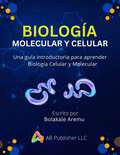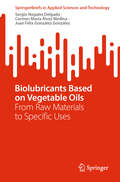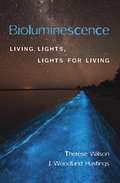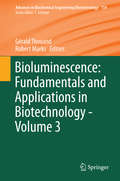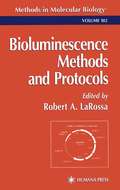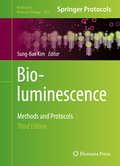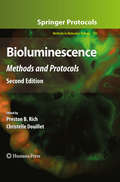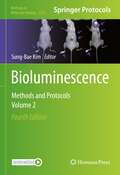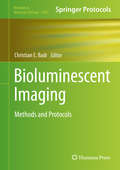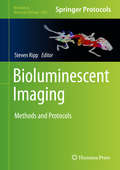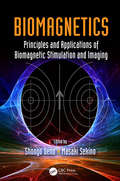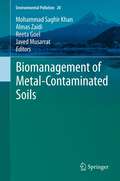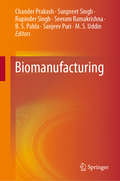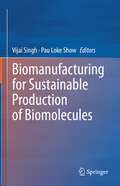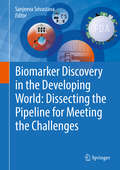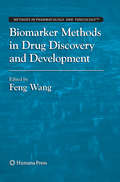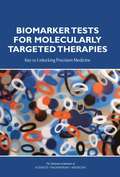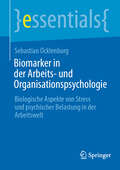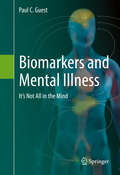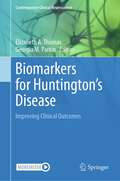- Table View
- List View
Biología Molecular y Celular: Una guía introductiva para aprender biología celular y molecular
by Bolakale AremuEste libro está diseñado para estudiantes que quieran aprender y apreciar temas biológicos básicos mientras estudian las menores unidades de la biología: moléculas y células. La biología celular y molecular es una disciplina dinámica. Hay miles de oportunidades en los campos médicos, farmacéuticos, agricultores, e industriales. Además de prepararte para una diversidad de trayectorias profesionales, entender la biología molecular y celular te ayudará a tomar buenas decisiones que pueden beneficiar tu dieta y salud.
Biolubricants Based on Vegetable Oils: From Raw Materials to Specific Uses (SpringerBriefs in Applied Sciences and Technology)
by Sergio Nogales Delgado Carmen María Álvez Medina Juan Félix González GonzálezThis is a book about biolubricants. It provides a general overview of these useful products, paying attention to their contribution to green and sustainable chemistry or the circular economy through the implementation of biorefineries. But also, it is a book about General Chemistry, Physics, Engineering, etc., as this specific subject could act as a cornerstone for many multidisciplinary fields. The book’s chapters include several exercises and questions to track reader’s learning and give general and specific idea of how biolubricants are not just a promising research topic, but also a practical reality. The main ideas covered in this work are the following: history, origin and use of biolubricants, main chemical routes to produce them and their quality assessment.
Bioluminescence
by Therese Wilson J. Woodland HastingsBioluminescence is everywhere on earth-most of all in the ocean, from angler fish in the depths to the flashing of dinoflagellates at the surface. Here, Thérèse Wilson and Woody Hastings explore the natural history, evolution, and biochemistry of the diverse array of organisms that emit light. While some bacteria, mushrooms, and invertebrates, as well as fish, are bioluminescent, other vertebrates and plants are not. The sporadic distribution and paucity of luminous forms calls for explanation, as does the fact that unrelated groups evolved completely different biochemical pathways to luminescence. The authors explore the hypothesis that many different luciferase systems arose in the early evolution of life because of their ability to remove oxygen, which was toxic to life when it first appeared on earth. As oxygen became abundant and bioluminescence was no longer adequate for oxygen removal, other antioxidant mechanisms evolved and most luminous species became extinct. Those light-emitting species that avoided extinction evolved uses with survival value for the light itself. Today’s luminous organisms use bioluminescence for defense from predators, for their own predatory purposes, or for communication in sexual courtship. Bioluminescence was earlier viewed as a fascinating feature of the living world, but one whose study seemed unlikely to contribute in any practical way. Today, bioluminescence is no longer an esoteric area of research. Applications are numerous, ranging from the rapid detection of microbial contamination in beef and water, to finding the location of cancer cells, to working out circuitry in the brain.
Bioluminescence: Fundamentals and Applications in Biotechnology - Volume 2 (Advances in Biochemical Engineering/Biotechnology #154)
by Gérald Thouand Robert MarksThis book review series presents current trends in modern biotechnology. The aim is to cover all aspects of this interdisciplinary technology where knowledge, methods and expertise are required from chemistry, biochemistry, microbiology, genetics, chemical engineering and computer science. Volumes are organized topically and provide a comprehensive discussion of developments in the respective field over the past 3-5 years. The series also discusses new discoveries and applications. Special volumes are dedicated to selected topics which focus on new biotechnological products and new processes for their synthesis and purification. In general, special volumes are edited by well-known guest editors. The series editor and publisher will however always be pleased to receive suggestions and supplementary information. Manuscripts are accepted in English.
Bioluminescence: Methods And Protocols (Methods in Molecular Biology #102)
by Robert A. LarossaA state-of-the-art collection of innovative methods for the use of luciferase and green fluorescent protein in analytical biochemistry, molecular toxicology, environmental monitoring, and cell-based assays. The contributors-all hands-on researchers who have perfected their protocols to a high degree of reproducibility-illustrate these powerful methods with a wide variety of applications ranging from the analytical determination (titer) of specific molecules to the cellular detection of a wide range of pollutants, to microbiological detection and analysis, and the molecular biological manipulation of lux, luc, and gfp structural genes. Step-by-step methods are also included for the construction of other recombinant organisms.
Bioluminescence: Methods and Protocols (Methods in Molecular Biology #1461)
by Sung Bae KimThis volume presents detailed laboratory protocols regarding the three major route technologies luciferases, efficient optical probes, and applications to visualizing molecular events in living subjects. "Bioluminescence: Methods and Protocols, Third Edition" guides readers through chapters on ingredients of bioluminescent probes, and fabrication of bioluminescent probes, applications to living subjects and instrumentations. Written in the highly successful "Methods in Molecular Biology "series format, chapters include introductions to their respective topics, lists of the necessary materials and reagents, step-by-step, readily reproducible laboratory protocols, and tips on troubleshooting and avoiding known pitfalls. Authoritative and practical, "Bioluminescence: Methods and Protocols, Third Edition" is a useful complement to the first and second edition for new and experienced researchers alike.
Bioluminescence: Methods and Protocols (Methods in Molecular Biology #574)
by Christelle Douillet Preston B. RichThrough the study and application of bioluminescence, scientists have painstakingly harnessed a powerful tool that enables us to seek a deeper understanding of the complex mechanisms underpinning so many vital biologic systems. In this fully revised and updated second edition of Bioluminescence: Methods and Protocols, expert researchers contribute a readable and utilitarian compilation of the newest and most innovative techniques that have emerged in this rapidly expanding and progressively diverse field including methods to assess cell trafficking, protein-protein interactions, intracellular signaling, and apoptosis. Also opening up the possibility to visualize and quantify biological mechanisms in real-time and in in vivo settings, the volume also describes the in vivo study of bacterial or viral infections, transplanted cells, stem cells proliferation, vascular flow, and tumors. Written in the highly successful Methods in Molecular BiologyTM series format, chapters include brief introductions to their respective topics, lists of the necessary materials, equipment, and reagents, step-by-step, readily reproducible laboratory protocols, and notes on troubleshooting and avoiding known pitfalls. Authoritative and cutting-edge, Bioluminescence: Methods and Protocols, Second Edition provides protocols that are detailed enough to be followed and adapted by scientific teams who have no previous expertise in bioluminescence in order to foster the potentially numerous breakthroughs and new applications from basic to applied science and medicine that must continue to be developed.
Bioluminescence: Methods and Protocols, Volume 1 (Methods in Molecular Biology #2524)
by Sung-Bae KimThis detailed collection explores recent advances in molecular imaging techniques involving bioluminescence, currently employed in biolaboratories around the world. Volume 1 delves into techniques for the establishment of luciferins and luciferases, basic in vitro and in vivo applications, as well as protocols on multiplex imaging platforms. Written for the highly successful Methods in Molecular Biology series, chapters include introductions to their respective topics, lists of the necessary materials and reagents, step-by-step, readily reproducible laboratory protocols, and tips on troubleshooting and avoiding known pitfalls. Authoritative and comprehensive, Bioluminescence: Methods and Protocols, Fourth Edition, Volume 1 presents practical guidance for researchers and technical staff on how to proceed with bioluminescence studies in their laboratories.
Bioluminescence: Methods and Protocols, Volume 2 (Methods in Molecular Biology #2525)
by Sung-Bae KimThis detailed collection explores recent advances in molecular imaging techniques involving bioluminescence, currently employed in biolaboratories around the world. Volume 2 delves into techniques for heterogeneous conjugates, protein fragment-complementation assays, BRET-based imaging, as well as instrumentation and software. Written for the highly successful Methods in Molecular Biology series, chapters include introductions to their respective topics, lists of the necessary materials and reagents, step-by-step, readily reproducible laboratory protocols, and tips on troubleshooting and avoiding known pitfalls. Authoritative and comprehensive, Bioluminescence: Methods and Protocols, Fourth Edition, Volume 2 presents practical guidance for researchers and technical staff on how to proceed with bioluminescence studies in their laboratories.
Bioluminescent Imaging: Methods and Protocols (Methods in Molecular Biology #1098)
by Christian E. Badr"Bioluminescent Imaging: Methods and Protocols" distills a wide range of techniques that use bioluminescence imaging as a tool for visualizing and tracking various biological processes. Covering diverse fields such as cellular and molecular biology, oncology, neurology, infectious diseases, immunology, and others, the detailed chapters of this volume are arranged by topic and describe practical procedures and applications of different bioluminescent reporters, from photoproteins (Aequorin) to bacterial luciferases as well as other secreted (such as Gaussia) and non-secreted luciferases (such as Firefly). Written in the highly successful "Methods in Molecular Biology" series format, chapters include introductions to their respective topics, lists of the necessary materials and reagents, step-by-step, readily reproducible laboratory protocols, and expert tips for troubleshooting and avoiding known pitfalls. Authoritative and cutting-edge, "Bioluminescent Imaging: Methods and Protocols" aims to provide diverse and comprehensive techniques to researchers interested in implementing bioluminescence-based imaging in their laboratory, regardless of their previous level of experience with such methodologies.
Bioluminescent Imaging: Methods and Protocols (Methods in Molecular Biology #2081)
by Steven RippThis volume provides detailed protocols and methodologies required to perform bioluminescent imaging in multiple stages, enabling the reader to integrate this technology into their laboratory-based imaging experiments. Written in the highly successful Methods in Molecular Biology series format, chapters include introductions to their respective topics, lists of the necessary materials and reagents, step-by-step, readily reproducible laboratory protocols, and tips on troubleshooting and avoiding known pitfalls. Authoritative and cutting-edge, Bioluminescent Imaging: Methods and Protocols to ensure successful results in the further study of this vital field.
Biomagnetics: Principles and Applications of Biomagnetic Stimulation and Imaging
by Trevor R. HodkinsonDiscover the Most Advanced Technologies in BiomagneticsCo-edited by Professor Ueno, a leader in the biomagnetics field for over 40 years, Biomagnetics: Principles and Applications of Biomagnetic Stimulation and Imaging explains the physical principles of biomagnetic stimulation and imaging and explores applications of the latest techniques in neuroscience, clinical medicine, and healthcare. The book shows you how the techniques are used in hospitals and why they are so promising. A brief overview of recent research trends in biomagnetics provides you with an up-to-date, informative guide to explore further in this field.The book focuses on three important areas: Magnetic nerve stimulation and transcranial magnetic stimulation Biomagnetic measurements and imaging of the human brain by advanced technologies of magnetoencephalography and MRI Biomagnetic approaches to potential treatments of cancers, pains, and other neurological and psychiatric diseases, such as Alzheimer’s disease and depression These core areas of the book were developed from the editors’ prestigious graduate-level courses in biomedical engineering. The text also discusses biomagnetic approaches to advanced medicine, including regenerative and rehabilitation medicine.
Biomanagement of Metal-Contaminated Soils (Environmental Pollution #20)
by Javed Musarrat Almas Zaidi Mohammad Saghir Khan Reeta GoelHeavy-metal contamination is one of the world's major environmental problems, posing significant risks to agro-ecosystems. Conventional technologies employed for heavy-metal remediation have often been expensive and disruptive. This book provides comprehensive, state-of-the-art coverage of the natural, sustainable alternatives that use a wide range of biological materials in the removal/detoxification of heavy metals, consequently leading to the improvement of crops in these soils. Novel, environmentally friendly and inexpensive solutions are presented based on a sound understanding of metal contamination and the roles of plants and microbes in the management of these toxic soils. Written by worldwide experts, the book provides not only the necessary scientific background but also addresses the challenging questions that require special attention in order to better understand metal toxicity in soils and its management through bioremediation.
Biomanufacturing
by Seeram Ramakrishna Rupinder Singh Chander Prakash Sunpreet Singh B. S. Pabla Sanjeev Puri M. S. UddinCurrent Trends in Biomanufacturing focuses on cutting-edge research regarding the design, fabrication, assembly, and measurement of bio-elements into structures, devices, and systems.The field of biomaterial and biomanufacturing is growing exponentially in order to meet the increasing demands of for artificial joints, organs and bone-fixation devices. Rapid advances in the biological sciences and engineering are leading to newer and viable resources, methods and techniques that may providing better quality of life and more affordable health care services.The book covers the broad aspects of biomanufacturing, including:synthesis of biomaterials;implant coating techniques;spark plasma sintering;microwave processing; andcladding, powder metallurgy and electrospinning.The contributors illustrate the recent trends of biomanufacturing, highlighting the important aspects of biomaterial synthesis, and their use as feedstock of fabrication technologies and their characterization, along with their clinical practices. Current Trends in Biomanufacturing updates researchers and scientists the novelties and techniques of the field, as it summarises numerous aspects of biomanufacturing, including synthesis of biomaterials, fabrication of biomedical structures, their in-vivo/ in-vitro, mechanical analysis and associated ISO standards.
Biomanufacturing for Sustainable Production of Biomolecules
by Pau Loke Show Vijai SinghThis book elucidates the sustainable production of commercially important biomolecules in medicines, food, and beverage processing, through biological systems, including microorganisms, animal cells, plant cells, tissues, enzymes, and in vitro. It discusses promising technologies for the manipulation of cells including, genetic engineering, synthetic biology, genome editing, and metabolic engineering. The initial chapters of the book introduce topics on biomanufacturing, circular economy, strain design and improvement, upstream and downstream processing. The subsequent chapters cover artificial intelligence-assisted production, designer cell factories, biosensors for monitoring biomolecules, different cells factories, biosynthetic pathways, and genome editing approaches for scale-up biomanufacturing. Lastly, the book discusses the opportunities and challenges of implementing biological systems for the production of biomolecules. This book is a valuable source for students, researchers, scientists, clinicians, stakeholders, policymakers, and practitioners to understand biomanufacturing for the sustainable production of biomolecules.
Biomarker Discovery in the Developing World: Dissecting the Pipeline for Meeting the Challenges
by Sanjeeva SrivastavaThis book is oriented towards post-graduates and researchers with interest in proteomics and its applications in clinical biomarker discovery pipeline. Biomarker discovery has long been the research focus of many life scientists globally. However, the pipeline starting from discovery to validation to regulation as a diagnostic or therapeutic molecule follows a complex trajectory. This book aims to provide an in-depth synopsis on each of these developmental phases attendant to biomarker "life cycle" with emphasis on the emerging and significant role of proteomics. The book begins with a perspective on the role of biorepositories and need for biobanking practices in the developing world. The next chapter focuses on disease heterogeneity in context to geographical bias towards susceptibility to the disease and the role of multi-omics techniques to devise disruptive innovations towards biomarker discovery. Chapter 3 focuses on various omics-based platforms that are currently being used for biomarker discovery, their principles and workflow. Mass spectrometry is emerging as a powerful technology for discovery based studies and targeted validation. Chapter 4 aims at providing a glimpse of the basic workflow and considerations in mass spectrometry based studies. Rapid and aptly targeted research funding has often been deemed as one of the decisive factors enabling excellent science and path breaking innovations. With the need for sophistication required in multi-omics research, Chapter 5 focuses on innovative funding strategies such as crowdfunding and Angel philanthropy. Chapter 6 provides the latest advances in education innovation, the premise and reality of bioeconomy especially in a specific context of the developing world, not to mention the new concept of "social innovation" to link biomarkers with socially responsible and sustainable applications. Chapter 7, in ways similar to biomarkers, discusses the biosimilars as a field that has received much focus and prominence recently due to their immense potential in clinical and pharmaceutical innovation literatures. The broader goal post-biomarker discovery is to translate their use in clinics. However, the road from bench-to-bed side is arduous and complex that is subject to oversight from various national and international regulatory bodies. Chapter 8 underscores these regulatory science considerations and provides a concise overview on intellectual property rights in biomarker discovery. Thus, this book contributed by eminent biomarker scientists, clinicians, translational researchers and social scientists holistically covers the various facets of the biomarker discovery journey from "cell to society" in developing world. The lessons learned and highlighted here are of interest to the life sciences community in a global and interdependent world.
Biomarker Methods in Drug Discovery and Development (Methods in Pharmacology and Toxicology)
by Feng WangIn this book, expert researchers provide a tool box for those who have a general interest in biomarker research and for those currently specializing in certain technologies but desiring an understanding of other available methodologies. Its chapters include validated, mature methods as well as new, incredibly promising protocols. This book is the perfect biomarker technical guideline and reference to stimulate more exciting biomarker research and technology development.
Biomarker Tests for Molecularly Targeted Therapies: Key to Unlocking Precision Medicine
by Engineering Medicine National Academies of SciencesEvery patient is unique, and the evolving field of precision medicine aims to ensure the delivery of the right treatment to the right patient at the right time. In an era of rapid advances in biomedicine and enhanced understanding of the genetic basis of disease, health care providers increasingly have access to advanced technologies that may identify molecular variations specific to an individual patient, which subsequently can be targeted for treatment. Known as biomarker tests for molecularly targeted therapies, these complex tests have the potential to enable the selection of the most beneficial treatment (and also to identify treatments that may be harmful or ineffective) for the molecular underpinnings of an individual patient’s disease. Such tests are key to unlocking the promise of precision medicine. Biomarker tests for molecularly targeted therapies represent a crucial area of focus for developing methods that could later be applicable to other areas of precision medicine. The appropriate regulatory oversight of these tests is required to ensure that they are accurate, reliable, properly validated, and appropriately implemented in clinical practice. Moreover, common evidentiary standards for assessing the beneficial impact of biomarker-guided therapy selection on patient outcomes, as well as the effective collection and sharing of information related to those outcomes, are urgently needed to better inform clinical decision making. Biomarker Tests of Molecularly Targeted Therapies examines opportunities for and challenges to the use of biomarker tests to select optimal therapy and offers recommendations to accelerate progress in this field. This report explores regulatory issues, reimbursement issues, and clinical practice issues related to the clinical development and use of biomarker tests for targeting therapies to patients. Properly validated, appropriately implemented biomarker tests hold the potential to enhance patient care and improve outcomes, and therefore addressing the challenges facing such tests is critical.
Biomarker Validation
by Sarah Schumacher Harald SeitzFrom the Contents: * Biomarkers - Past and Future * Quantitative Proteomics Techniques in Biomarker Discovery* Biomarker Qualification: A Company Point of View* Biomarker Discovery and Medical Diagnostic Imaging* Breath: An Often Overlooked Medium in Biomarker Discovery* HTA in Personalized Medicine Technologies* Bone Remodeling Biomarkers: New Actors on the Old Cardiovascular Stage* Identification and Validation of Breast Cancer Biomarkers* Evaluation of Proteomic Data: From Profiling to Network Analysis by Way of Biomarker Discovery* Biomarkers: From Discovery to Commercialization* Clinical Validation* Genomics and Proteomics for Biomarker Validation For Biochemists, Clinical Chemists, Oncologists, Laboratory Medics, and Analytical Research Institutes.
Biomarker in der Arbeits- und Organisationspsychologie: Biologische Aspekte von Stress und psychischer Belastung in der Arbeitswelt (essentials)
by Sebastian OcklenburgDieses essential gibt einen Überblick über Biomarker-Forschung in der Arbeits- und Organisationspsychologie. Dabei werden die zentralen Biomarker und Methoden zur Erfassung von Biomarkern erläutert. Der Autor beleuchtet spezifisch relevante Biomarker für psychische Erkrankungen im Kontext der Arbeitswelt sowie Biomarker für psychische Belastungsfolgen der Arbeit wie Burn-out. Das essential endet mit einer praxisorientierten Erläuterung organisationaler und finanzieller Aspekte von biopsychologischer Forschung in der Arbeitswelt.
Biomarkers And Occupational Health: Progress And Perspectives
by Mortimer L.Mendelsohn John P.Peeters Mary Janet NormandyBiomarkers have emerged as an exciting tool in disease prevention, particularly in the workplace. They may be used to document workers' exposure to toxins, signal the onset of health effects, or identify individuals with susceptibility to certain environmental threats. But the uncertainty is as great as the potential. Are biomarkers suitable for widespread use? How can they be deployed in diverse contexts? How can biological information about workers be handled fairly and ethically?Biomarkers and Occupational Health describes the state of biomarker development, including the implications of the Human Genome program, and presents a range of viewpoints on the future of biomarkers from the leaders in the field.This book explores the three basic types of biomarkers (markers of exposure, markers of health effects, and markers of susceptibility to disease) from a variety of perspectives. It examines what can be learned from well-known exposure sites--Hiroshima and Nagasaki, Chernobyl, and the Hanford nuclear site in the United States, for example--and a wide range of human cases and animal studies. The book also explores the costs and ramifications of developing a large-scale program to monitor potentially exposed workers (e.g., at a cleanup site).A framework is offered for the use of biomarkers based on the mandate to "change the environment before you change the worker." The book explores how to identify ethical issues, how to set development priorities, and how to integrate biomarkers into an occupational health and safety program.The authors present the latest technical findings about markers for chronic beryllium disease as well as markers for exposure to carcinogens, radiation, and chronium--including prospects for detecting long-past exposures.Biomarkers and Occupational Health offers an update on biomarker development and explores a wide scope of issues. This book will be important to occupational health professionals, biomedical researchers, toxicologists, epidemiologists, and labor and management officials involved in worker health issues.Moritmer L. Mendelsohn, M.D., Ph.D., is Vice-Chairman of the Radiation Effects Research Foundation (RERF) in Japan, which studies the long-term health effects of the atomic blasts in Hiroshima and Nagasaki, and he is former Associate Director of the Lawrence Livermore National Laboratory in California.John P. Peeters, Ph.D., is a geneticist who is currently directing a division of the Office of Occupational Medicine for the United States Department of Energy.Mary Janet Normandy, Ph.D., is a toxicologist who specializes in the metabolism of xenobiotics in mammalian systems. She is currently a member of the Department of Energy's Office of Occupational Medicine.
Biomarkers and Mental Illness: It’s Not All in the Mind
by Paul C. GuestEmploying accessible language throughout, this book covers the history of psychiatric research, the current state-of-the art in psychiatric practice, the physiological systems affected by psychiatric illnesses, the whole-body nature of these diseases and the impact that this aspect has on emerging biomarker discoveries. Further, it provides descriptions of the major specific psychiatric disorders and the special challenges regarding the diagnosis and treatment of each. The book concludes with insights into the latest developments in hand-held biomarker test devices, which can provide diagnostic information in less than 15 minutes in point-of-care settings. This book investigates the emerging use of biomarkers in the study of psychiatric diseases, a topic of considerable importance for a broad range of people including researchers, clinicians, psychiatrists, university students and even those whose lives are affected in some way by a psychiatric illness. The last category is hardly trivial, since a staggering one in three people worldwide show the criteria for at least one psychiatric disorder at some point in their lifetime.
Biomarkers for Alzheimer’s Disease Drug Development (Methods in Molecular Biology #2785)
by Robert PerneczkyThis fully updated volume provides an up-to-date and comprehensive overview of the current state of technologies helping to accelerate Alzheimer’s disease drug development. Addressing the latest advances in preclinical and clinical research, including new insights into the molecular mechanisms and emerging therapeutic strategies, the book continues by exploring digital biomarkers and advanced neuroimaging analysis which will transform how clinical trials in the Alzheimer’s disease field are performed. Written for the highly successful Methods in Molecular Biology series, chapters feature the kind of detailed implementation advice that leads to greater success in the lab or clinic. Authoritative and practical, Biomarkers for Alzheimer’s Disease Drug Development, Second Edition seeks to inspire and inform future efforts to develop effective treatments for this devastating disease.
Biomarkers for Endometriosis
by Thomas D'HoogheThis book presents an overview of the diagnostic performance of non- or semi-invasive tests for endometriosis in peripheral blood, endometrium, saliva, peritoneal fluid and urine. The value of existing and emerging systems biology technologies for biomarker development is addressed in several chapters on genetics, microarrays, proteomics and metabolomics. Although tests with high sensitivity and acceptable specificity have been developed, sometimes validated in independent populations and seem promising, more research is needed to translate these data into clinical benefit for patients and coordinate efforts internationally to standarize analysis, reports and operating procedures. The gold standard to diagnose endometriosis is currently through laparoscopic inspection with histological confirmation, a surgical procedure with rare but significant potential risks for the patients. A non-invasive test for endometriosis would be critical for the early detection of endometriosis of symptomatic women with pelvic pain and/or subfertility with normal ultrasound. This would include nearly all cases of minimal-mild endometriosis, some cases of moderate-severe endometriosis without a clearly visible ovarian endometrioma and cases with pelvic adhesions and/or other pelvic pathology, who might benefit from surgery to improve pelvic pain and/or subfertility. Such a test would also be useful in symptomatic women with ultrasound imaging suspicious for endometriosis, since it may be difficult to differentiate an ovarian endometrioma from other ovarian cysts and since the quality of ultrasound imaging is highly variable worldwide.
Biomarkers for Huntington's Disease: Improving Clinical Outcomes (Contemporary Clinical Neuroscience)
by Elizabeth A. Thomas Georgia M. ParkinHuntington’s disease (HD) is a fatal, inherited, neurodegenerative disorder, characterized by chorea, motor instabilities, psychiatric manifestations and cognitive decline. Early genetic testing provides an opportunity for clinical interventions aimed at delaying onset and/or slowing progression of disease; however, current treatments for HD are limited, with only two FDA-approved drugs available to manage chorea. Encouragingly, however, several disease-modifying treatment approaches are in the therapeutic pipeline, with more than 200 clinical studies, and many more preclinical studies, in the works. Robust and reliable biomarkers are needed to predict disease onset, monitor disease progression and assess treatment responses. More specifically, biomarkers to stratify patients for clinical trials and biomarkers to track drug efficacy will certainly lead to improved clinical trial design and success. This book represents the first book focused solely on biomarkers for HD and represents a distinct resource that will be informative, not only for clinicians and those involved in clinical trial design, but also for a wide range of neurodegenerative disease researchers. This edited volume is written by top leaders in the field, and takes a cross-disciplinary approach to cover a broad spectrum of biomarker types, in order to provide the latest advances in the development of biochemical, molecular, imaging and digital biomarkers that have been investigated for HD. With the ultimate goal of treating patients, the development of disease-associated biomarkers has never been more important.
